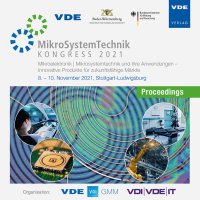Experimental Characterization Method for Passive Microvalves in Diaphragm Pumps for Medical Applications
Conference: MikroSystemTechnik Kongress 2021 - Kongress
11/08/2021 - 11/10/2021 at Stuttgart-Ludwigsburg, Deutschland
Proceedings: MikroSystemTechnik Kongress 2021
Pages: 4Language: englishTyp: PDF
Authors:
Gruenerbel, Lorenz (Fraunhofer EMFT, Research Institution for Microsystems and Solid State Technologies, Munich, Germany & Technical University Munich, Germany)
Leikam, Barbara (Vienna University of Technology, Vienna, Austria)
Schrag, Gabriele (Technical University Munich, Germany)
Abstract:
Microfluidic components can improve medical devices or even enable new applications. Medical use often comes along with complex requirements, leading to intricate specifications for all microfluidic components. Key devices are micro-pumps that can be used as actuators, e.g., for drug delivery or hydraulic application. They basically consist of an actuator, a pump chamber and valves. In this work, we focus on the optimization of the passive valves, where we always face the tradeoff between blocking capability (high fluidic resistance in off phase) and low flow resistance when opened. Especially, hydraulic medical applications such as a penile prosthesis require high flow rates and a high-pressure generation, hence very tight valves. To further improve the fluidic performance, it is obligatory to analyze the valve behavior in detail. Literature research shows deficits in the investigation of microvalves with a view to experimental data using liquid as a medium. However, measurements are inevitable for the validation of derived valve models and, hence, for the optimization of the valves itself and the entire fluidic system. To this end, we implemented and calibrated a meas-urement setup, which enables to determine the deflection of the valve diaphragm operating in liquids. This provides a deeper understanding of the valve operation, thus enabling further optimization with respect to the fluidic requirements on the whole system. We first discuss measurements comparing the valve behavior in water and air and hence provide additional design input derived from the extracted data.


